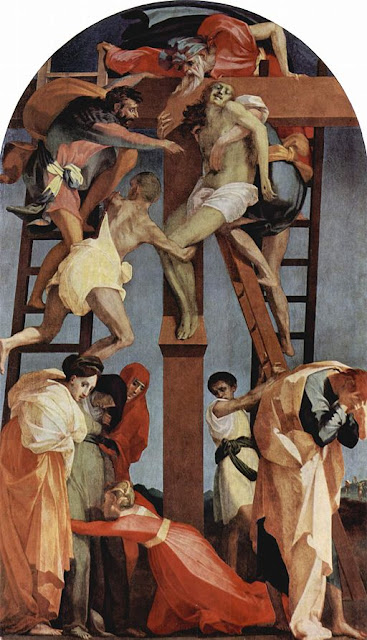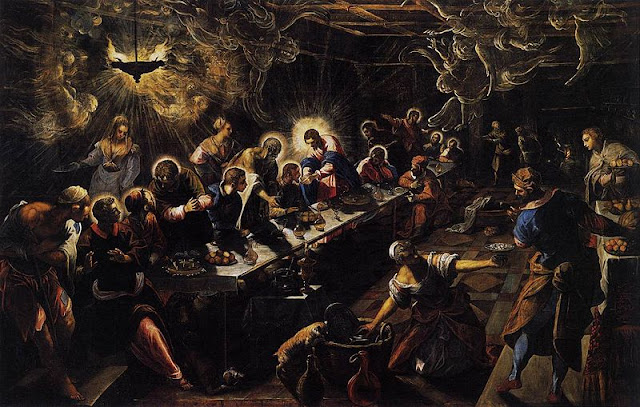Italian Renaissance painter Sandro Botticelli (1445-1510) is one of the best known artists in the world. However most people don't realize his name wasn't really "Botticelli" at all, it was a nickname which means "little barrel" in Italian. The name referred to the well-rounded nature of his older brother who was a government official in Florence, and then later became his own nickname. His given name was actually Alessandro di Mariano di Vanni Filipepi.Botticelli's nickname has gone down in history as being synonymous with the art of the Italian Renaissance which began in Florence in the early 15th century. Nearly everyone has heard of him, yet if you were to ask people about the paintings of "di Vanni Filipepi" most would not know which artist was being referred to.
 |
| La Primavera, Botticelli, 1478, Uffizi Gallery, Florence |
Nicknames were commonplace for artists in Botticelli's time, especially in Italy. Let's look at several other well known painters from the 13th to the 17th century whose nicknames are still in use today. You may have heard of some or all of these artists, often people don't realize centuries later that we are referring to them by their nicknames and not their given names.
Cimabue
Cenni di Pepi (1240-1302)
In Italian this nickname means "Ox Head" which presumably refers to the artist's stubbornness. Cimabue is thought by many to be the Father of Italian Renaissance art, his name is mentioned in Dante's famous poem. Cimabue was known for his beautiful Madonna and Child paintings and was also the teacher of the painter Giotto.
 |
| The Tribute Money, Masaccio, 1425, fresco, Santa Maria del Carmine, Florence |
Masaccio and Masolino
Tommaso di Ser Giovanni di Simone (1401-1428)
Tommaso di Cristoforo Fini (1383 – c. 1447)
The given name of both of these early Italian Renaissance artists is "Tommaso" and both nicknames were taken from that. Tommaso di Ser Giovanni di Simone was better known as "Masaccio" which means "clumsy Tom" or "messy Tom." Tommaso di Cristoforo Fini was called "Masolino" meaning "little Tom" in Italian. Both artists worked in Florence and they collaborated on the famous Brancacci Chapel frescos. Masaccio's fresco of The Tribute Money (shown above) is the first time perspective was accurately applied in Renaissance art.
 |
| Monument to Sir John Hawkwood, Uccello, 1436, Duomo of Florence |
Paolo Uccello
Paolo di Dono (1397-1475)
In Italian the word uccello means “bird,” and Paolo was a naturalist who painted many animals, his nickname was inspired by his paintings of birds. The famous 16th century art historian Giorgio Vasari writes this of Uccello in his book The Lives of the Artists-
"In the house of the Medici he painted some scenes on canvas and in distemper, representing animals; in these he eve took delight, and in order to paint them well he gave them very great attention, and, what is more, he kept ever in his house pictures of birds, cats, dogs and every sort of strange animal whereof he could get the likeness, being unable to have them alive by reason of his poverty; and because he delighted in birds more than in any other kind, he was given the name of "Paolo of the Birds."
Uccello also lived and worked in Florence and during his life created many paintings including the famous Monument to Sir John Hawkwood in the Duomo of Florence. Hawkwood was promised an equestrian monument as a memorial, but to save money this one was painted rather than created as a life-size bronze statue.
 |
| The Doubting of St. Thomas, Verrocchio, 1467-83, Orsanmichele, Florence |
Andrea del Verrocchio
Andrea di Michele di Francesco de’ Cioni (1435-1488)
Verrocchio means “true eye,” in Italian and there are two thoughts on how he acquired that nickname. The first is that the moniker 'true eye' was used to refer to his artistic talents. The other is that Andrea received his first training from a goldsmith named Giuliano da Verrocchi and when he started his own artistic career he took on his name.
In art history Verrocchio is best known as the teacher of Leonardo da Vinci. In his successful workshop in Florence Andrea del Verrocchio trained other Renaissance artists including Perugino (Raphael's teacher). Verrocchio worked in painting as well as sculpture and his clients included the Medici family.
 |
| The Tempest, Giorgione, 1503-04, Accademia, Venice |
Giorgione
Giorgio Barbarelli da Castelfranco (1447-1511)
In Italian, "Giorgione" means "Big George" taken from his given name Giorgio. Giorgione is considered to be the ‘Father of the Venetian Renaissance Style” of painting, though he only lived into his early 30’s and is thought to have died of the plague. Only a handful of his surviving paintings are acknowledged for certain to be his work. He worked closely with the artist Titian who passed his style incorporating rich colors down through the 16thcentury.  |
Immaculate Conception and Birth of the Virgin Mary, Domenico Ghirlandaio, 1485-90
Tornabuoni Chapel, Santa Maria Novella, Florence
Domenico Ghirlandaio Domenico di Tommaso di Currado di Doffo Bigordi (1449-1494) In Italian 'ghirlandaio' means “garland maker,” which was his father's profession. Ghirlandaio lived and worked in Florence and was one of the most sought after fresco artists of his time. Michelangelo got his artistic start in the workshop of Ghirlandaio and was one of the assistants in the frescos for Santa Maria Novella.
|
 |
Descent from the Cross, Rosso Fiorentino, 1521
|
Rosso Fiorentino Giovanni Battista di Jacopo (1495-1540)
Giovanni the "Red Florentine" got his nickname from his hair color. He was a well known Mannerist painter who worked in both Florence and in France in the early 16th century. Fiorentino was trained along with Jacopo Pontormo in the studio of Andrea del Sarto.  |
The Last Supper, Tintoretto, San Giorgio Maggiore, Venice, 1592-94
|
Tintoretto
Jacopo Robusti (1518-1594)
Jacopo was the son of a dyer (tintore in Italian) giving him his nickname. Tintoretto was one of the most prolific and influential painters in the Venetian Renaissance. His hallmark artistic style was to start with a dark background and use bold colors and strong highlights. His brushwork and use of perspective added much depth and drama to his paintings.
El Greco
Domenikos Theotokopoulos (1541-1614)
His nickname meant "The Greek" in Spanish as he was born on the island of Crete and spent the majority of his career working in Spain, primarily in Toledo. El Greco created one of the most distinctive styles of painting in this time period. He was influenced by both Greek Orthodox icon painting, a Venetian sense of coloring (since Crete was under Venetian rule at this time and he spent some time in Venice) and Spanish art after he moved to Spain.
Michelangelo de Merisi (1571-1610)
This artist came from the town of Caravaggio in Northern Italy and it was not uncommon for artists to get nicknamed based on their place of origin if they later moved.
Caravaggio was an Italian painter of the Baroque period who lived a tumultuous life, he murdered a man in Rome and spent the next several years moving around Italy. Around 1600 Caravaggio developed his famous style of extreme chiaroscuro (painting form with lights and darks) known as "tenebrism" which was a turning point in art. Many other artists followed his style of dark backgrounds with dramatic highlights.
This list of 12 famous artists known by their nicknames are only some artists known by a name other than their own, there are actually quite a few more. All create interesting stories throughout art history.
Bibliography
Hartt, Frederick and David Wilkins. History of Italian Renaissance Art, Painting∙Sculpture∙Architecture. Prentice Hall, 2010.
The Lives of the Artists (Oxford World's Classics) by Giorgio Vasari. Translated from Italian by Julia Conway Bondanella and Peter Bondanella. Oxford University Press, 1998.
Santi, Bruno. Botticelli. Milan: Scala, 1999.


























